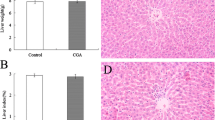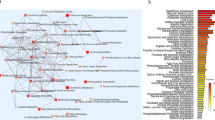Abstract
Cheetahs in captivity are frequently afflicted by chronic disease conditions that are rare in their free-ranging counterparts and in other felids. To date, clear pathophysiological mechanisms for some of these diseases have not been established. In order to better understand these conditions in this species, we have adopted a systems biology approach to cheetah metabolism, with the hope of generating new hypotheses for future research. As part of a comprehensive metabolome, we determine the serum (N = 42) and urine (N = 26) amino acid profiles of apparently healthy captive cheetahs, housed at the AfriCat Foundation in Namibia, using GC-MS and LC-MS-MS. A total of 36 serum and 38 urine amino acids were identified and quantified. Glutamine was detected in the serum at the highest mean concentration (1624 μmol/L) followed by alanine (771.9 μmol/L), arginine (669.8 μmol/L), and glycine (478.7 μmol/L). Serum glycine, hydroxyproline, prolylproline, proline, and serine concentrations declined significantly with age. Arginine was excreted at the highest mean concentration (740 μmol/L), followed by glutamine (437.1 μmol/L), alanine (397.1 μmol/L), and serine (331.1 μmol/L). The fractional excretion of cystine was by far the highest at 21.92%, followed by hydroxylysine (6.34%), proline-hydroxyproline (5.49%), and α-aminopimelic acid (4.89%). Both urinary glycine and proline-hydroxyproline concentrations decreased significantly with age. None of the serum or urine amino acid concentrations differed significantly between males and females. This study provides some foundational information on the serum and urine amino acid profiles of healthy captive cheetahs.


Similar content being viewed by others
References
Albanese AA, Orto LA (2012) Urinary excretion of amino acids 1. Elsevier
Armstrong MD, Stave U (1973) A study of plasma free amino acid levels. III. Variations during growth and aging. Metabolism 22:571–578
Azuma K, Osaki T, Tsuka T, Imagawa T, Minami S, Okamoto Y (2012) Plasma free amino acid profiles of canine mammary gland tumors. J Vet Sci 13:433–436. https://doi.org/10.4142/jvs.2012.13.4.433
Blazer-Yost B, Jezyk PF (1979) Free amino acids in the plasma and urine of dogs from birth to senescence. Am J Vet Res 40:832–838
Chan DL, Rozanski EA, Freeman LM (2009) Relationship among plasma amino acids, C-reactive protein, illness severity, and outcome in critically ill dogs. J Vet Intern Med 23:559–563. https://doi.org/10.1111/j.1939-1676.2009.0296.x
Datta SP, Harris H (1952) Urinary amino-acid patterns of some mammals. Ann Eugenics 17:107–116
Delmas PD, Eastell R, Garnero P, Seibel MJ, Stepan J (2000) The use of biochemical markers of bone turnover in osteoporosis. Osteoporos Int 11:S2–S17
Deng P, Jones JC, Swanson KS (2014) Effects of dietary macronutrient composition on the fasted plasma metabolome of healthy adult cats. Metabolomics 10:638–650
Dull TA, Henneman PH (1963) Urinary hydroxyproline as an index of collagen turnover in bone. N Engl J Med 268:132–134
Evered DF (1967) Species differences in amino acid excretion by mammals. Comp Biochem Physiol 23:163–171
Fowler ME (1986) Metabolic bone disease. In: Zoo and wild animal medicine, 2nd edn. WB Saunders Co., Philadelphia, pp 69–90
Hall WL, Millward DJ, Long SJ, Morgan LM (2003) Casein and whey exert different effects on plasma amino acid profiles, gastrointestinal hormone secretion and appetite. Br J Nutr 89:239–248
Hanssen I, Lunde H, Gjessing LR (1989) Plasma amino acids in dogs with osteochondrosis or hip dysplasia. Acta Vet Scand 30:111–112
Hargrove DM, Rogers QR, Calvert CC, Morris JG (1988) Effects of dietary excesses of the branched-chain amino acids on growth, food intake and plasma amino acid concentrations of kittens. J Nutr 118:311–320
Heinze CR, Larsen JA, Kass PH, Fascetti AJ (2009) Plasma amino acid and whole blood taurine concentrations in cats eating commercially prepared diets. Am J Vet Res 70:1374–1382. https://doi.org/10.2460/ajvr.70.11.1374
Hendriks WH, Moughan PJ, Tarttelin MF, Woolhouse AD (1995) Felinine: a urinary amino acid of Felidae. Comp Biochem Physiol B Biochem Mol Biol 112:581–588
Hoppe A, Denneberg T, Jeppsson JO, Kagedal B (1993) Urinary excretion of amino acids in normal and cystinuric dogs. Br Vet J 149:253–268. https://doi.org/10.1016/S0007-1935(05)80171-X
Longenecker JB, Hause NL (1959) Relationship between plasma amino acids and composition of the ingested protein. Arch Biochem Biophys 84:46–59
McMenamy RH, Lund CC, Neville GJ, Wallach DF (1960) Studies of unbound amino acid distributions in plasma, erythrocytes, leukocytes and urine of normal human subjects. J Clin Invest 39:1675–1687. https://doi.org/10.1172/JCI104191
Miller RC, Brindle E, Holman DJ, Shofer J, Klein NA, Soules MR, O'Connor KA (2004) Comparison of specific gravity and creatinine for normalizing urinary reproductive hormone concentrations. Clin Chem 50:924–932. https://doi.org/10.1373/clinchem.2004.032292
Milsom JP, Morgan MY, Sherlock S (1979) Factors affecting plasma amino acid concentrations in control subjects. Metabolism 28:313–319
Morris JG (2002) Idiosyncratic nutrient requirements of cats appear to be diet-induced evolutionary adaptations. Nutr Res Rev 15:153–168. https://doi.org/10.1079/NRR200238
Morris JG, Rogers QR (1978) Ammonia intoxication in the near-adult cat as a result of a dietary deficiency of arginine. Science 199:431–432
Munson L, Nesbit JW, Meltzer DGA, Colly LP, Bolton L, Kriek NP (1999) Diseases of captive cheetahs (Acinonyx jubatus jubatus) in South Africa: a 20-year retrospective survey. J Zoo Wildl Med 30:342–347. https://doi.org/10.2307/20095876
Munson L, Terio KA, Worley M, Jago M, Bagot-Smith A, Marker L (2005) Extrinsic factors significantly affect patterns of disease in free-ranging and captive cheetah (Acinonyx jubatus) populations. J Wildl Dis 41:542–548. https://doi.org/10.7589/0090-3558-41.3.542
Mustonen A-M, Puukka M, Pyykönen T, Nieminen P (2005) Adaptations to fasting in the American mink (Mustela vison): nitrogen metabolism. J Comp Physiol B Biochem Syst Environ Physiol 175:357–363. https://doi.org/10.1007/s00360-005-0492-2
Okame R, Nakahara K, Murakami N (2015) Plasma amino acid profiles at various reproductive stages in female rats. J Vet Med Sci 77:815–821
Rogers QR, Morris JG (1979) Essentiality of amino acids for the growing kitten. J Nutr 109:718–723
Silber RH, Porter CC (1949) Urinary excretion of amino acids and peptides by dogs fed protein hydrolysates or amino acids. J Nutr 38:155–164
Stipanuk MH, Caudill MA (2013) Biochemical, physiological, and molecular aspects of human nutrition. Elsevier Health Sciences
Stipanuk MH, Dominy JE, Lee J-I, Coloso RM (2006) Mammalian cysteine metabolism: new insights into regulation of cysteine metabolism 1,2. 1652–1659
Tapiero H, Mathe G, Couvreur P et al (2002) I. Arginine. Biomed Pharmacother 56:439–445. https://doi.org/10.1016/S0753-3322(02)00284-6
Tarttelin MF, Hendriks WH, Moughan PJ (1998) Relationship between plasma testosterone and urinary felinine in the growing kitten. Science 65:83–87
Tordiffe ASW, Van Der Watt GF, Reyers F et al (2012) Cystine urolithiasis in a caracal (Caracal caracal). J Zoo Wildl Med 43:649–651. https://doi.org/10.1638/2011-0236R1.1
Tordiffe ASW, Wachter B, Heinrich SK, Reyers F, Mienie LJ (2016) Comparative serum fatty acid profiles of captive and free-ranging cheetahs (Acinonyx jubatus) in Namibia. PLoS One 11:e0167608. https://doi.org/10.1371/journal.pone.0167608
Tordiffe ASW, van Reenen M, Reyers F, Mienie LJ (2017) Gas chromatography-mass spectrometry profiles of urinary organic acids in healthy captive cheetahs (Acinonyx jubatus). J Chromatogr B Anal Technol Biomed Life Sci 1049–1050:8–15. https://doi.org/10.1016/j.jchromb.2017.02.018
Worden AN, Waterhouse CE, Sellwood EHB (1960) Studies on the composition of normal cat urine. J Small Anim Pract 1:11–23
Acknowledgments
We would like to thank all the staff at the AfriCat Foundation for their support and assistance with the project. We would also like express our gratitude to Mr. Jano Jacobs and Mrs. Ansie Mienie for their assistance with the processing and analysis of the samples.
Funding
This work was supported by the AfriCat Foundation and North West University.
Author information
Authors and Affiliations
Corresponding author
Ethics declarations
Conflict of interest
The authors declare that they have no conflict of interest.
Ethical approval
The project was approved by the National Zoological Gardens of South Africa’s Research and Ethics Committee (Project no. P11/07). A research/collecting permit (1846/2013) was obtained from the Namibian Ministry of Environment and Tourism and the samples were imported into South Africa with the required CITES export (no.0042838) and import (no. 137670) permits, as well as a veterinary import permit (no. 13/1/1/30/2/10/6-2013/11/002397). Once in South Africa, the samples were transported and stored with the required national Threatened or Protected Species (TOPS) ordinary permit (no. 05238).
Rights and permissions
About this article
Cite this article
Tordiffe, A.S.W., Mienie, L.J. Serum and urine amino acid profiles of captive cheetahs (Acinonyx jubatus). Comp Clin Pathol 28, 287–296 (2019). https://doi.org/10.1007/s00580-018-2829-8
Received:
Accepted:
Published:
Issue Date:
DOI: https://doi.org/10.1007/s00580-018-2829-8




